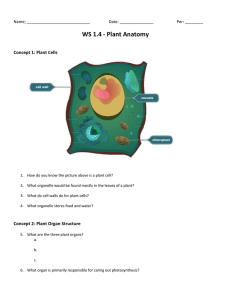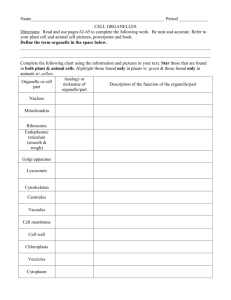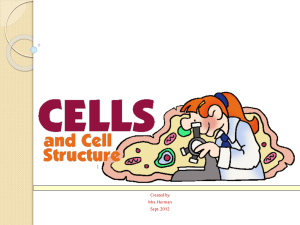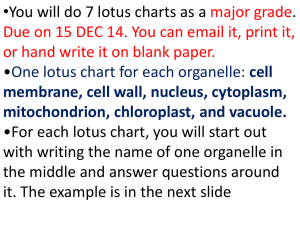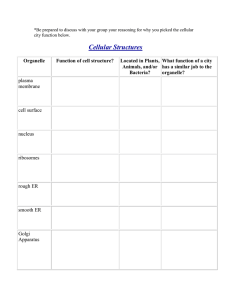cell wall and chloroplast
advertisement
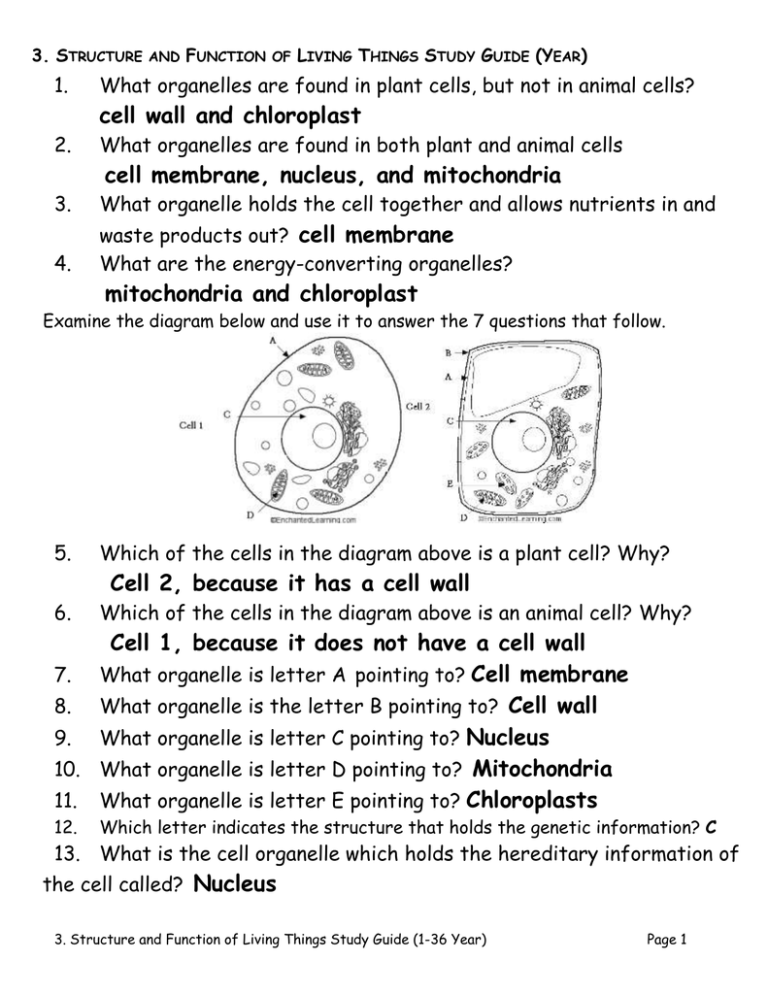
3. STRUCTURE 1. AND FUNCTION OF LIVING THINGS STUDY GUIDE (YEAR) What organelles are found in plant cells, but not in animal cells? cell wall and chloroplast 2. What organelles are found in both plant and animal cells cell membrane, nucleus, and mitochondria 3. What organelle holds the cell together and allows nutrients in and 4. waste products out? cell membrane What are the energy-converting organelles? mitochondria and chloroplast Examine the diagram below and use it to answer the 7 questions that follow. 5. Which of the cells in the diagram above is a plant cell? Why? Cell 2, because it has a cell wall 6. Which of the cells in the diagram above is an animal cell? Why? Cell 1, because it does not have a cell wall 7. What organelle is letter A pointing to? Cell membrane 8. What organelle is the letter B pointing to? Cell wall 9. What organelle is letter C pointing to? Nucleus 10. What organelle is letter D pointing to? Mitochondria 11. What organelle is letter E pointing to? Chloroplasts 12. Which letter indicates the structure that holds the genetic information? C 13. What is the cell organelle which holds the hereditary information of the cell called? Nucleus 3. Structure and Function of Living Things Study Guide (1-36 Year) Page 1 14. Which organelle uses sunlight to make energy? Chloroplasts 15. Why do plants need chloroplasts? Plants do not eat and need to convert light energy into sugar 16. Why do animal cells not need chloroplasts? Animals eat food to get sugar which is converted to energy 17. Why do both plant and animal cells have mitochondria? Both need to convert sugar into useable energy 18. What is the heredity material in a cell called? DNA- deoxyribonucleic acid 19. What is the function of DNA? Provide instructions for the function of the cell 20. What are the basic units of all living things? Cells 21. What are the basic needs of a cell? reproduce, use energy, remove wastes, transport nutrients 22. Why are cells considered the basic unit of life? Cells are the basic unit of life because cells are the smallest units (things) that can perform all of the functions of life. 23. A person has about 200 different kinds of cells; each specialized to do a particular job. This means that a person is what type of organism? Multicellular 24. What works together to form an organ? Tissues 25. What are some examples of plant and animal organs? Plant leaf, stem, stamen, anthers, stomach, heart, lung,etc. 26. List the levels of organization in order form smallest to largest. Cells, tissues, organs, organ systems, organism 27. What works together to make organ systems? Organs 28. What does an organ system need to function? Functioning organ systems need all of their organs functioning 3. Structure and Function of Living Things Study Guide (1-36 Year) Page 2 29. During a severe heart attack much of the tissue of the heart is damaged. How would this damage affect the organism? The tissue damage would affect the heart’s function causing the organism to possibly die. 30. When a person smokes the lungs become less effective at passing oxygen on to the blood. How does this affect the entire organism? Less oxygen enters the blood stream, causing more tissue damage to other organ systems. Examine the diagram below and use it to answer the 4 questions that follow. http://www.mrothery.co.uk/cellcycleandrepro/mitosisq1.htm 31. Which picture represents the phase where DNA is replicated? C (Interphase) 32. Which picture represents the phase where chromosomes are pulled apart? A (Anaphase) 33. Which picture represents the phase in which the nuclear membrane breaks down? B (Prophase) 34. Which picture represents the phase where the cell begins to divide? D (cytokinesis) 35. Why is mitosis necessary? Mitosis results in two "daughter cells", which are genetically identical to each other, and is used for growth and asexual reproduction. 36. Why is it necessary for the cell to duplicate DNA during mitosis? So that each new cell produced receives an exact copy of the DNA in the parent cell 3. Structure and Function of Living Things Study Guide (1-36 Year) Page 3 3. Structure and Function of Living Things Study Guide (Year) Correlation with District Standards 1. 2. 3. 4. 5. 6. 7. 8. 9. 10. 11. 12. 13. 14. 15. 16. 17. 18. 19. 20. 21. 22. 22. 23. 24. 25. 26. TOP: TOP: TOP: TOP: TOP: TOP: TOP: TOP: TOP: TOP: TOP: TOP: TOP: TOP: TOP: TOP: TOP: TOP: TOP: TOP: TOP: TOP: TOP: TOP: TOP: TOP: TOP: 27. 28. 29. 30. 31. 32. 33. 34. 35. GJUHSD 3a-4 GJUHSD 3a-4 GJUHSD 3a-2 GJUHSD 3a-2 GJUHSD 3a-4 GJUHSD 3a-4 GJUHSD 3a-5 GJUHSD 3a-5 GJUHSD 3a-5 GJUHSD 3a-5 GJUHSD 3b-2 GJUHSD 3b-3 GJUHSD 3b-3 GJUHSD 3a-3 GJUHSD 3a-3 GJUHSD 3a-3 GJUHSD 3a-3 GJUHSD 3b-1 GJUHSD 3b-1 GJUHSD 3d-1 GJUHSD 3a-1 GJUHSD 3a-1 GJUHSD 3d-2 GJUHSD 3d-2 GJUHSD 3d-2 GJUHSD 3d-1 GJUHSD 3d-2 TOP: GJUHSD 3d-3 TOP: GJUHSD 3d-3 TOP: GJUHSD 3d-4 TOP: GJUHSD 3d-4 TOP: GJUSHD 3c-2 TOP: GJUSHD 3c-2 TOP: GJUHSD 3c-2 TOP: GJUHSD 3c-2 TOP: GJUHSD 3c-1 36. TOP: GJUHSD 3c-3 3. Structure and Function of Living Things Study Guide (1-36 Year) Page 4
